Witch stereotypes run rampant in 2017, and a few have withstood the test of time. When asked to describe a common witch, a person’s first instinct might be to include the iconic black pointed hat and robes, a broomstick, a green hooked nose, and bubbling potion cauldrons. Have you ever paused to wonder where all of these tropes come from, though?
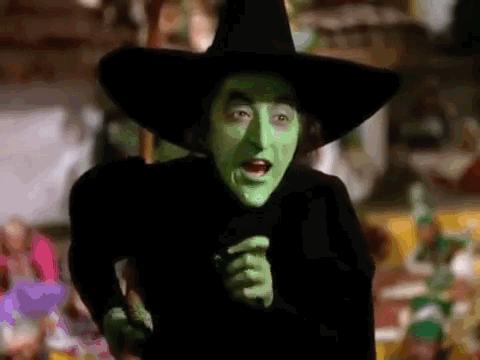
As we’ve talked about before, witches during the panic of the 16th century didn’t exactly walk around the village with emerald-green skin and donning all black to demonstrate her affiliation with the devil. The truth is, some of these modern ideas we have about witches come from equally modern sources, while others are even debated in their true origin.
Black Conical Hat, Black Robes
Unfortunately for high school students everywhere, the witchy villains in their assigned readings like The Crucible didn’t walk around in black robes and a pointed hat, indicating they were friendly with the devil. After all, that’d be too easy! Such clothing wasn’t exactly a common fashion statement, so where did the stereotype come from?
One theory bases the hat’s possible shape on the once-popular hennin, a tall, pointed hat donning a veil at the tip that’s commonly associated with medieval princesses. Such can be seen in this print from Robert Hunt’s book on Cornish folklore, clearly showing the parade of witches riding broomsticks and their familiars, all the while wearing dark clothing, and many of them wearing the aforementioned conical hat:
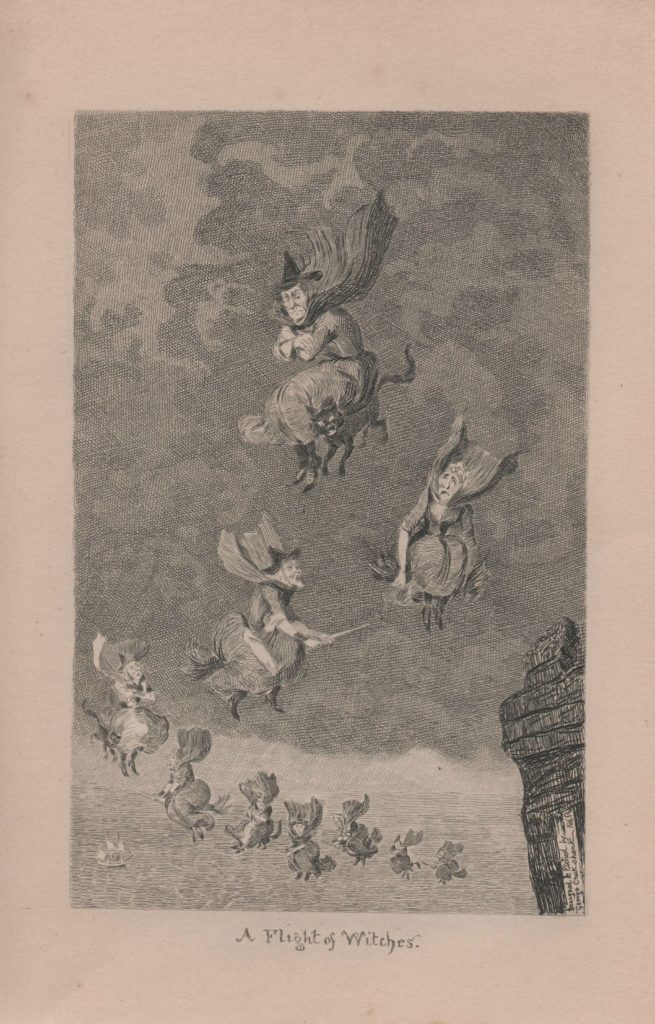
Another interesting portrayal comes from Francisco de Goya, and his painting Witches’ Flight:
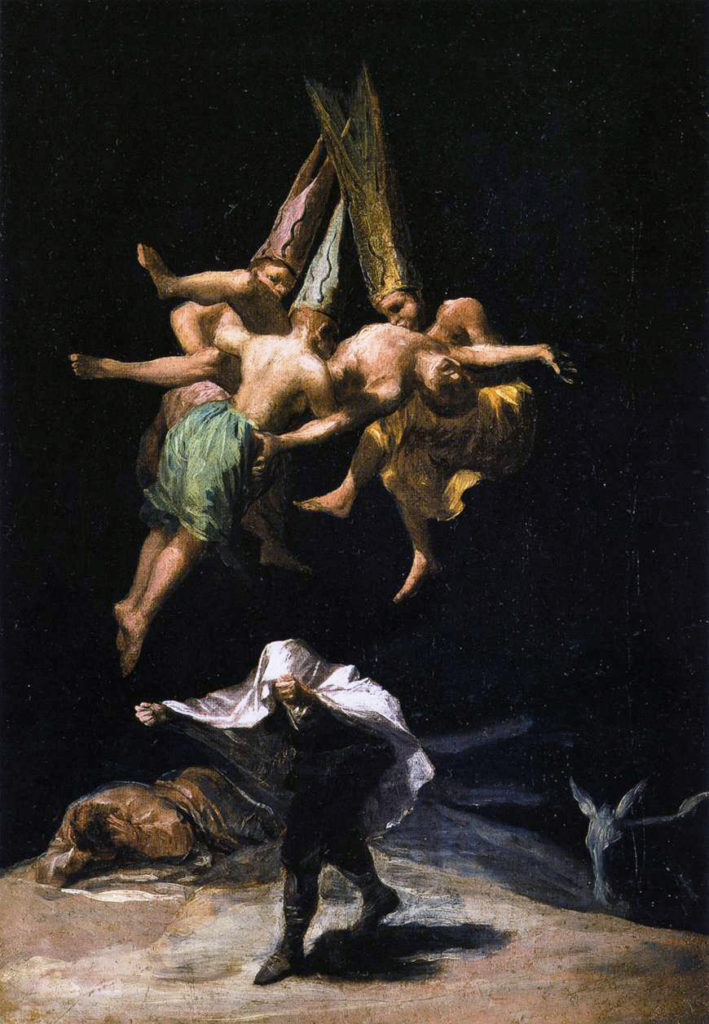
Despite the witches being male, which certainly was historically accurate in many cases, you can clearly see their pointed, though brimless, hats indicating they are magic users. In fact, in old lore, the brimless conical hat was used to symbolize magicians/sorcerers in men. Along that line of thinking, it’s speculated that at some point the brim was added for portrayals of women as it made them appear more feminine. Are brimmed hats the secret to unlocking womanly wiles?
Other theories suggest the point was used to symbolize the horns of the devil, which to me sounds way more accurate. Not to mention, kind of cool.
Green Skin
Picture a witch with green skin — who do you see? I bet I can guess!
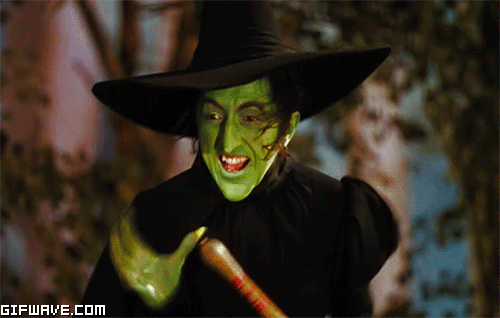
Portrayed by the late Margaret Hamilton, the Wicked Witch of the West was the key villain we all know and loved (and possibly feared) from the 1939 movie The Wizard of Oz.
In the original novelization of the story by L. Frank Baum in 1900, however, she was never described as being green; in fact, it was completely a decision made by the producers of the movie to portray her with the sickly skin. Before she made her first appearance, witches were actually characterized as having orange or red colored skin in illustrated depictions.
So why green, then? Well, for the sake of Technicolor, of course! According to Linda Rodriguez on BoingBoing.net, “It seems that the only reason MGM’s famously revolving team of filmmakers, customers, and screenwriters decided on green was that it looked suitably scary and otherworldly — and that it showed up really well on film.”
As such, with the massive popularity of the film that came after — not to mention the subsequent spin-offs and their Broadway plays — it’s no surprise that the modern rendition of a Halloween witch took on the same color of skin. When it comes to why she was so affected by water, however, you’ll just have to read the book to find out.
Broomsticks
Just like the origin of the memorable pointed cap, the relationship between witches and broomsticks is a little bit blurred, but one theory stands out above the rest:
During the witch-hunting frenzy of the middle ages and beyond, human beings were learning the magic of plant-based hallucinogens (pun intended). A few of the more popular herbs included hemlock, nightshade, henbane, and mandrake, all of which contain a chemical called tropane alkaloids that have a fun hallucinogenic effect on a person when ingested — that is, if you can get over the stomach and digestive issues, or possible death that comes with them.
The chemicals were so addictive, though, that people began to go to any length to enjoy them without the side effects. Eventually, it was discovered that when absorbed through the skin the herbs didn’t have the same negative symptoms, particularly through the sweat glands of the armpits or through the membranes of genitalia.
Following this discovery, the herbs started being applied to the sticks of brooms, of which people would then throw a leg over and have a good time running around the house hallucinating all the while.
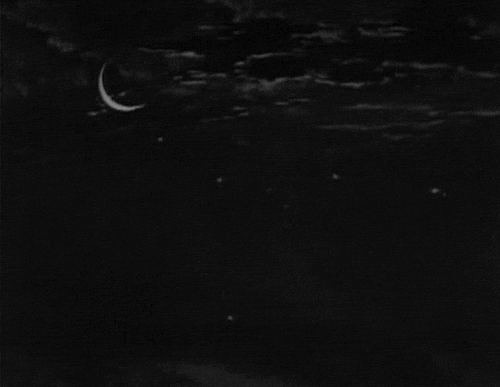
Naturally then, it’s understandable how witches came to own the stereotype of flying on brooms. Acting strangely while straddling a broomstick, probably in the presence of others who were just as high on the drug as they were, it’s easy to imagine the kinds of tricks played on the imagination.
In this thorough post by MentalFloss on the subject, it quotes toxicologist Gustav Schnek on the topic of the hallucinogens, describing how he felt “an intoxicating sensation of flying … I soared where my hallucinations — the clouds, the lowering sky, herds of beasts, falling leaves which were quite unlike any ordinary leaves, billowing streamers of steam and rivers of molten metal — were swirling along.”
This is also a theorized source of the potion cauldron that many a witch was suspected of having in her home, aka the “witch’s brew”. It wasn’t actually a big bubbling cauldron of potion for doing the devil’s work, though — just a big bubbling cauldron of good times.
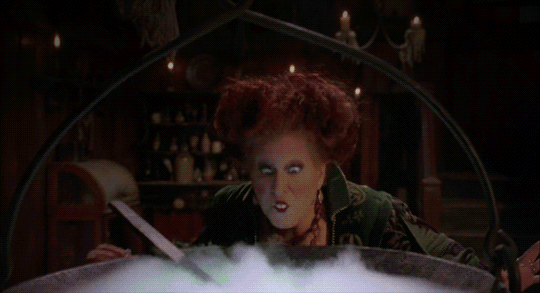
When considering the origins and once panic-stricken mainstream opinion of witches, it’s rather intriguing to see the turn it’s taken on the modern everyday culture. No longer are there massive hunts being conducted on the daily in search of those who are friendly with the devil. In fact, the “witch aesthetic” is a booming fashion and home decor business, and witches and wizards are a huge source of appeal in the world of entertainment, to the point of theme parks being constructed around their fictional lives.
Personally, I’m all in favor of the change. Not because I too am a woman who wears a lot of black, talks to her cats, is generally associated with others who do the same, and would otherwise certainly be accused of practicing witchcraft — well, actually, that is probably why.

Want to read more about the origins of these stereotypes? Check out these links!
Why Black Cats Are Considered Bad Luck
Why Do Witches Wear Pointy Hats?
Kelsey graduated from Boise State University with a BA in Visual Arts, and is currently working as a freelance writer, while doodling anime on the side with one hand and petting cats with the other.

Oh Kelsey, you are genius! How do you think up these awesome articles? LOVE IT! And your sense of humor…totally dig it!